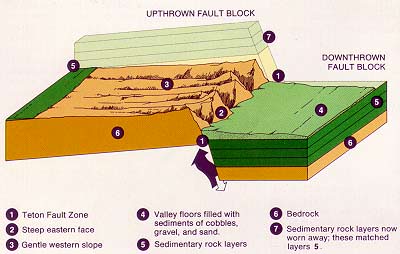[/caption]
Fault-block mountains are formed by the movement of large crustal blocks when forces in the Earth’s crust pull it apart. Some parts of the Earth are pushed upward and others collapse down.
To understand a fault-block mountain, or sometimes referred as a “fault mountain”, you need to understand what a fault is. Faults are simply cracks in the Earth’s crust. The surface of the Earth can move along these faults, and displace rock layers on either side. Wherever you have movement along the faults, you can get earthquakes, and over long periods of time mountains form under the intense pressure.
Large blocks of rock along the sides of these faults can be uplifted and tilted sideways by this incredible force. And then, on the opposite sides of the faults, the ground tilts downwards forming a depression. This depression gets filled in and leveled by the erosion of the mountains above.
The Sierra Nevada mountains in California are an example of a fault-block mountain range.
We have written many articles about the Earth for Universe Today. Here’s an article that shows how satellites can calculate the movement of the Earth during earthquakes.
Want more resources on the Earth? Here’s a link to NASA’s Human Spaceflight page, and here’s NASA’s Visible Earth.
We have also recorded an episode of Astronomy Cast about Earth, as part of our tour through the Solar System – Episode 51: Earth.

